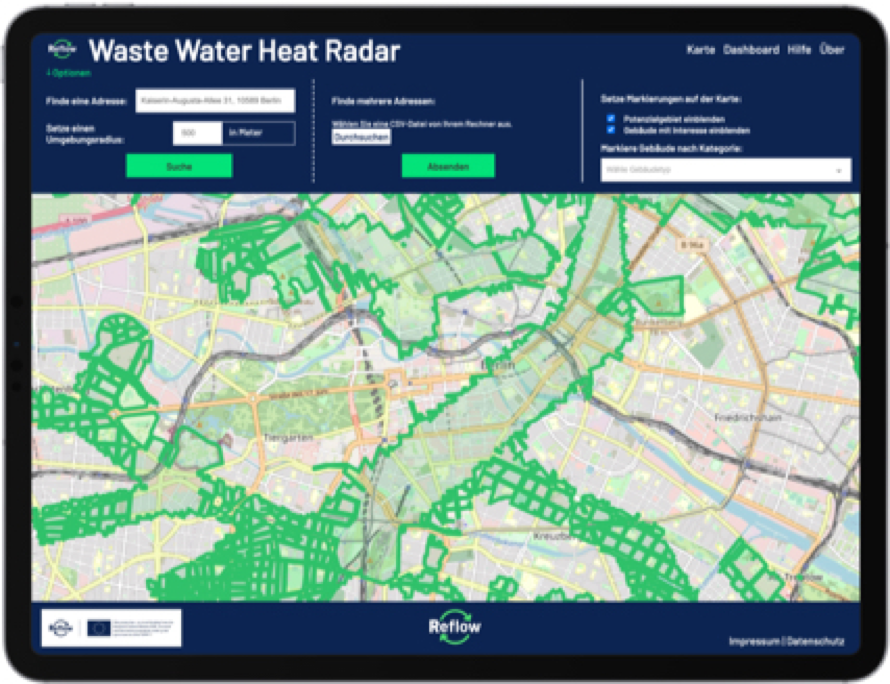Berlin Waste Heat Radar Promoting Technologies for Heat Transition
A solution that facilitates waste heat recovery for Berlin and beyond
Waste heat recovery is a small but relevant building block on the way to achieve the energy policy goal of relative energy self-sufficiency. At the same time it can play an important role in the energy transition taking place in the building and construction sector. Developed initially for the recovery of heat from wastewater, the “waste heat radar” is a promising tool to achieve greater awareness and utilization of waste heat potentials in metropolitan areas and beyond.
Berlin Wastewater Heat Radar
REFLOW project serving as umbrella for innovation in circular resource flows
The waste heat radar has been conceptualized and developed into a prototype as part of a EU-funded project titled ‘REFLOW’. This project aims to understand and transform urban resource flows. It develops and tests appropriate solutions that establish circular economy practices.
Teams in Amsterdam, Berlin, Cluj-Napoca, Milan, Paris and Vejle with Copenhagen Business School being the coordinating partner, have come up with approaches to circular economies in vastly different industry segments. These pilots focus on very different resource flows.
In Berlin it’s all about waste heat, especially wastewater heat
The Berlin project partners have set themselves the goal of presenting data on heating potential and requirements in such way that the use of wastewater heat will be encouraged. This is done by using a web application in the style of a radar with the purpose to increase awareness about wastewater heat potentials, and increase the number of implementations at residential and commercial properties. Importantly, the radar enables matchmaking between suppliers of waste heat and potential users. In the future waste heat potentials generated by machine waste heat are to be mapped in an analogous manner.
Energy from waste heat can be moved between locations by using latent heat storage. The starting point of the research group is the observation that there is no transparent and lean process to identify optimal locations for waste water heat energy systems and to stimulate the dialogue between implementation partners.
The Berlin team is made up of four partners: (i) Prototypes for Europe (P4E), a technology transfer organization and leader of the Berlin pilot, (ii) Fraunhofer Fokus, a large research organization, (iii) MCS Datalabs, a technology firm mostly focusing on backend development in the Berlin consortium and (iv) Berliner Wasserbetriebe, Berlin’s water utility.
What makes waste heat so interesting from an ecological and energy policy perspective?
As per a recent analysis of the Bundesverband Wämepumpe e.V., around one eighth of the heat requirement in Germany can theoretically be covered by wastewater heat. As CO2-neutral heat with a high flow temperature, it is unquestionably preferable to linear thermal energy. The Berlin project group estimates that thermal energy obtained from wastewater in Berlin currently amounts to a low 3 megawatts per year, while the potential is about 275 megawatts. If one considers that waste heat has already been produced by definition and that an unexpected increase in energy prices is currently being observed, it is obvious to try using this potential.
How does the prototype of the radar work?
The basic idea of ??the waste heat radar is to make the complicated issue of waste heat recovery easier to handle for private and public actors. It is based on a wealth of data showing the locations of properties in the metropolitan area that can either emit large amounts of heat energy or absorb it.
This is particularly challenging for wastewater heat because there are not many data about waste heat emissions. One must consider where exactly the sewer pipes are without which the transport of the warm sewage is not possible. There is also the question of where heat exchangers can be installed. In order to fill this gap different data sources have been used to provide the necessary depth of information to allow for wastewater heat recovery and matchmaking between supply and demand. In detail:
- Data on sewer infrastructure
- Simulation data from Prototypes for Europe with which the heating loads of properties can be estimated
- Specific other data that help formulating important parameters for the simulation data
The result is a rich and realistic picture of the properties in the metropolitan region that can serve as a solid base for efficient trading of waste heat between public and private suppliers and users.
Next steps: consideration of other types of waste heat and connection of suitable service providers
So far, the Berlin waste heat radar has functioned as an instrument for Berliner Wasserbetriebe and its project partners, above all Prototypes for Europe. They are currently already using the radar to inform property owners and operators about their opportunities to obtain more information and possibly implement sustainable heat technology. In view of the dramatic price development of relevant raw materials, this is of particular interest to many property owners and operators.
